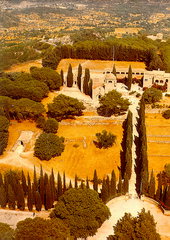|
Introduction
The island of Rhodes is situated at the crossroads of two major sea routes
of the Mediterranean between the Aegean Sea and the coast of the Middle
East, as well as Cyprus and Egypt. The meeting point of three continents,
it has known many civilizations.
Throughout its long history the different people who settled on Rhodes
left their mark in all aspects of the island's culture: art, language,
architecture. Its strategic position brought to the island great wealth
and made the city of Rhodes one of the leading cities of the ancient Greek
world.
|
 |
Classical Period
The island was inhabited as early as the late Neolithic period (4000
B.C.). In 408 B.C. the three major cities of the island - Ialyssos,
Kamiros and Lindos - founded the city of Rhodes. The three centuries
that followed were the golden age of Rhodes. Sea trade, skilled
shipbuilders, and the careful and open-minded political and diplomatic
manoeuvres of the city kept it strong and prosperous until Roman
times.
In the same period, Rhodes produced excellent artistic work. The most
celebrated of all was the Colossus, one of the Seven Wonders of the
Ancient World, made between 304 and 293 B.C. by the Lyndian sculptor
Hares. The construction of the Colossus took 12 years and was finished
in 282 BC. For years, the statue, representing their sun god Helios,
stood at the harbour entrance, until a strong earthquake hit Rhodes
about 226 BC. The city was badly damaged, and the Colossus was
demolished. |
|
The urban plan of ancient Rhodes reflects directly
the urban and philosophical ideas of the famous ancient Greek planner,
Hippodamus. The street plan of the ancient city is known due to
decades of archaeological excavations. The building blocks (insulae)
measure 47.70X26.50 m and all have the same dimensions. They included
3 houses each and were surrounded by streets 5-6 meters wide. Greater
units constituted areas surrounded by wider streets (8-11 meters).
Every area included 36 insulae or 108 houses. The ancient city had an
extended and well-constructed sewage system as well as a water supply
network |
|
|
|
Roman period
The independence of the city came to an end in 164 B.C. when Rhodes
became a Province of the Roman Empire. But even as late as the 1st
century A.D. Rhodes preserved much of its splendour and developed into
one of the greatest centres of learning, science and the arts.
Apart from the surviving written sources, the archaeological research
which continues to this day gives us a clear idea of the level of
civilization during this period.
|
 |
Early Christian period
During the early Christian period (330-650 A.D.) Rhodes belonged to
the eastern part of the Christianised Roman Empire, which is known in
history as the Byzantine Empire.
Though less significant and prosperous than before, the city was the
See of a Bishop and had a great number of churches, among them some
basilicas of impressive dimensions. It was also an important military
base.
The Arabs, who appeared or the first time in the Mediterranean in the
7th century, attacked Rhodes and occupied it for sοme decades. The
city shrank during the following centuries and was fortified with new
walls. At the same time it was divided into two zones, one reserved
for the political and military leadership and the other where the
laymen lived, a division that reflects the social reality of medieval
times.
Due to lack of written sources we have little information concerning
this period. The restoration work of the Italians neglected or even
harmed surviving buildings in favour of the Knights’ period. |
|
Knights’ period.
In 1309 the island was sold to the Order of the Knights Hospitaliers
of Saint John of Jerusalem. The Order was established in the 12th
century in Jerusalem for the purpose of nursing pilgrims and
crusaders, but soon enough it was transformed into a combat unit and
acquired vast tracts of land.
Having retreated from Jerusalem and then Cyprus, the Order established
its Headquarters on Rhodes, taking a leading role in the Eastern
Mediterranean at this time.
During the Knights’ era the fortifications were extended, modernized
and continuously reinforced. Α hospital, a palace and several churches
were among the many public buildings constructed at that time,
offering interesting examples of Gothic and Renaissance architecture.
Ιn spite of the hostilities with the Ottoman Empire, sea trade was a
source of wealth and the markets of the city were thriving. Under the
Knights, the island had a period of prosperity and the relations
between them and the local population was characterized by tolerance
and often by close collaboration. Most of the streets of the Medieval
Town coincided with those of the ancient city. The division of the
town into two parts was retained. in Rhodes the Order kept a
well-organized archive that included documents issued by its
leadership, correspondence, notary acts, etc. The archive has survived
and is found today in the National Library of Malta. It constitutes a
valuable source of information for the period. |
 |
Ottoman Period
In 1522 the Ottoman Turks conquered the city after a second long
siege. New buildings were constructed: mosques, public baths and
mansions for the new patrons. The Greeks were forced to abandon the
fortified city and move to new suburbs outside its walls.
In the Ottoman era Rhodes lost its international character. The city
maintained its main economic function as a market for the agricultural
products of the interior of the island and the surrounding small
islands.
After the establishment of their sovereignty οn the island, the
Ottoman Turks repaired the damaged fortifications, converted most of
the churches into mosques and transformed the major houses into
private mansions or public buildings. This transformation was a
long-term process that aimed to adapt the buildings to the Ottoman way
of living. |
| The
Knights’ period facades with their sculptured decorations, the arched
gates and hewn stone walls were enriched with the random character of
the Ottoman architecture adapted to the local climate and culture. Ιn
this process most οf the architectural features of the existing
buildings were preserved. The most characteristic additions were the
baths (usually in the back of the buildings) and the enclosed wooden
balconies οn the facades over the narrow streets.In this this way most
of the buildings of the Hospitaliers' period in the Medieval Town were
well preserved. The result was a mixture of oriental architecture with
imposing western architectural remains and more recent buildings,
which were characteristic of the local architecture of the time. |
Itallian Period
Italian troops took over the island and the rest of the Dodecanese in
1912 and in 1923 Italy established a colony Isole Italiane del Egeo.
The Italians demolished the houses that had been built on and beside
the walls during the Ottoman era and turned the Jewish and Ottoman
cemeteries into a “green zone” surrounding the Medieval Town. They
preserved the remains of the Knights’ period and removed all the
Ottoman additions and also reconstructed the Grand Master’s Palace. In
addition, they established an Institute for the study of the History
and Culture of the region.
The Italians undertook extensive infrastructure works (roads,
electricity, port, etc.) and radically transformed the town of Rhodes,
which was supplied with a new urban plan, building regulations and
many new public and private buildings. |
|
Recent History
The English bombs that fell on the medieval city of Rhodes in 1944
claimed human lives and destroyed a great number of buildings, leaving
large gaps in the urban tissue. One of the first Decrees of the Greek
administration designated those areas as reserved for future
excavations and a number of edifices as safeguarded buildings.
In 1957, a new city plan was approved by a Decree and in 1960 the
entire medieval town was designated as a protected monument by the
Ministry of Culture. In 1961 and 1963 new Decrees were issued
concerning the new city plan. They provided for the widening of
existing streets and the opening of new ones. These were not
implemented in the old city due to the resistance of the
Archaeological Service. In 1988, the old town of Rhodes was designated
as a World Heritage City by UNESCO.
The Ministry of Culture, through the local Archaeological Service, is
the agency responsible by law for archaeological excavations and the
preservation of historic buildings and works of art.
One of the first tasks of the Archaeological Service was to
reconstruct and consolidate the extensively damaged fortifications and
the building which houses the Archaeological Museum. Upon excavation,
the north-east corner of the medieval city, which was bombed during
the war, revealed the fortification of the Hellenistic city in front
of the ancient great port (today’s commercial port). The scarcity of
construction of new buildings in the medieval city at that time gave
the Archaeological Service very few opportunities for excavations. On
the other hand, the building boom of the 1970’s and 1980’s in areas
outside the fortified city kept the archaeologists busy.
Later excavations in a private plot brought to light two historic
phases of the wall of the Hellenistic city, one before and one after
the siege of Demetrios Poliorkitis (the Besieger) (305-304 B.C.).
The base of the clock tower and the square tower of the Hospitalier
walls further to the east were some of the few known surviving
buildings of the Byzantine era. In excavations after 1980, two major
early Christian basilicas in the medieval city were revealed. The east
and a portion of the south Byzantine wall were also discovered.The
positions of the wall and towers of the Collachio wall were
identified.
In historic cities like Rhodes where contemporary life continues,
architectural conservation becomes a more complicated task. In an
attempt to cope with the complex new problems of the medieval city,
the Ministry of Culture, the Municipality of Rhodes and the
Archaeological Receipts Fund drew up a contract (1984) which resulted
in the establishment, in 1985, of the Office for the Conservation and
Restoration of the Medieval Town of Rhodes. The basic contract
concerning the medieval town aims at the enhancement of its historic
and cultural character, the improvement of living standards and the
development of productive activities. The objective of the contract is
to produce city planning projects as well as restoration studies, and
also to carry out restoration projects and archaeological excavations. |
Source: City of Rhodes Official site
© www.rhodes.gr
|
|